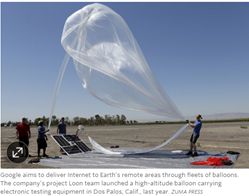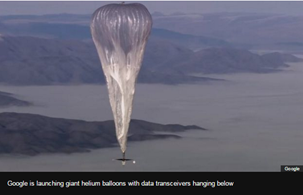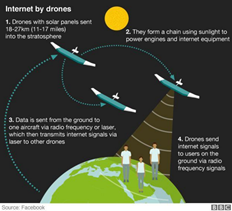Les Cottrell, Jan 2016
Balloons
The Google Project Loon weather balloons fly at 12 miles in the stratosphere. Beneath each lighter-than-air balloon are hung: two radio transceivers to receive and send data streams, plus a third back-up radio; a flight computer and GPS location tracker; an altitude control system, which is used to move the balloon up and down to find winds that will take it in the desired direction; solar panels to power all the gear. They are moved up and down to find the right winds to direct them into position usually travelling along an easterly or westerly latitude. Balloons regularly stay aloft for 150 days. Cover a circular area spanning 50 miles diameter. Balloons transmit using radio frequency and can also transmit to each other (up to 100km apart transferring data at ~500Mbps) to extend the Internet where there is no base station nearby. Can now supply connected devices with about 10 megabits a second to connected devices via antennae on the ground. Mike Cassidy, who heads project Loon, believes the total cost for Internet from balloons could be 10% or even 1% of Internet from satellites. He anticipates paying customers to be connecting to its web of balloons by 2016. See http://www.wsj.com/articles/the-internets-future-lies-up-in-the-skies-1418603566. Google's balloons are already active. Indeed, the firm hopes to start providing connections to early adopters in Indonesia and Sri Lanka soon."We put transponders on all our balloons, which is not required," says Mr Cassidy, "so, just like an aeroplane, air traffic control can always see where the balloons are." http://www.bbc.com/news/technology-34780127. "[We need] about 300 balloons or so to make a continuous string around the world." Google believes it is on course to have enough internet-beaming balloons in the stratosphere to form a ring over part of the world next year. The declaration coincides with the announcement that three of Indonesia's mobile networks intend to start testing Project Loon's transmissions next year. Sri Lanka previously signed a separate agreement signaling its wish to be another participant in the giant helium balloon-based scheme. See http://www.bbc.com/news/technology-34660205
Drones
In April 2014 Google bought solar-powered drone make Titan Aeropspace, little has been heard since.
Facebook aims to build a network of laser-beaming drones that will tightly circle known black-spots. Facebook drones (Aquila) fly for 3 months, operate 60Kft – 90Kft (above planes), launched by helium balloons (drone weighs 880lbs), circle a 2 mile radius. "The whole structure is 142ft (43m) wide but weighs less than a Toyota Prius," Mr Parikh explains. The aim is to build a fleet of the drones with radio transmitters fitted underneath to beam data across a 100 mile (160km) diameter zone below. (see http://www.bbc.com/news/technology-34780127). Drones communicate with ground and one another via lasers that use little power and are high speed. The drones can be up to 11km apart so the accuracy requires hitting a dime (18mm diameter) at 11 miles with both source and destination moving and temperature changes of nearly 200 degrees at 27km above the earth.
Once these atmospheric satellites are up there, there’s a wide range of possible applications. Facebook is obviously interested in internet connectivity, but mapping, meteorology, global positioning, rapid response to disasters and wildfires, and a whole slew of other scientific and military applications are also possible. (Read: Facebook creates Internet.org alliance to reduce price of mobile data plans to 1% of current price.)
Internet.org a Facebook-led initiative reaches 2/3 of world without reliable internet connection. The team is exploring a variety of technologies, including high-altitude long-endurance planes, satellites and lasers. Criticised by activists in both the developed and developing world for only linking users to a walled-garden version of the internet. Internet.org customers can access, for free, selected services such as Facebook, Wikipedia, weather, job listings and government info. But they cannot access the open web through the same service.
Satellites
Low and Medium Earth Orbit Satellites (LEOS, MOES)
Medium Earth Orbit Satellites like O3b Networks, which orbit 5,000 miles above Earth. These satellites are large and powerful like their geostationary counterparts, but aren’t plagued with the issues of latency.
Hedging its bets, perhaps, Google has plans to invest more than $1 billion in satellites for Internet access. Google is planning to launch a fleet of 180 satellites to provide web access for the 4.8 billion people not yet online, according to sources close to the company. Google's venture was being led by Greg Wyler, founder of satellite-communications start-up O3b Networks, and depending on the network's final design, the group may double the number of proposed satellites. http://www.dailymail.co.uk/sciencetech/article-2646039/Googles-plans-world-domination-Search-giant-launch-180-satellites-bring-internet-access-ENTIRE-planet.html#ixzz3xiYaUjJq
The former CEO of 03b, Greg Wyler, who was briefly at Google, is now collaborating with Elon Musk’s SpaceX to create a network of hundreds of low-Earth orbit satellites.
http://oneweb.world/ announced an ambitious constellation of over 600 Low Earth Orbiting Satellites that can communicate with remote place, disasters, 30K feet flying planes etc.
Both Iridium and Globalstar, pioneers in networks of low-Earth orbit satellite networks, have spent time in bankruptcy.
Already, traditional players like Intelsat, the world’s largest satellite company by market capitalization, is using the capabilities of its next-generation geostationary satellites to deliver Internet connectivity to airplanes, cruise ships, the world’s merchant marine fleet, all markets that “basically didn’t exist five to seven years ago,” says David McGlade, CEO of Intelsat.
Geostationary Satellites (GSO)
ViaSat appear to be getting round the problem of request/responses taking ~ 0.5 second on geostationary satellite links (and hence leading to long delays to complete loading of web pages) by aggregating the multiple request/reponses for the web objects in a page. However this will not assist for real time applications such as quick action first person shooter gaming or haptic surgery or Voice over IP. For VoIP the concern is the RTT delays of 500ms for geostationary satellite plus any delays between the ground stations and the conversants, plus de-jitter buffer etc. exceeds the recommended specifications for VoIP (see for example http://www.voip-info.org/wiki/view/QoS and ITU-T G.114). In particular long delays result in difficulty for the conversants to know when the speaker is done.
ViaStat's focus is currently on the aviation, military, business, and consumer sectors in the Americas, Europe and East Asia and not on the addressing the other 3 billion with no Internet access in regions such as Africa. Besides having fixed based terminals, they also have portable satellite terminals <http://www.satcomresources.com/Viasat-Exede-Pro-Portable-Satellite-Terminal> . Until ViaSat-2 is launched, they have limited Inflight Wi-Fi on "JetBlue and some United Airlines commercial planes <http://www.sandiegouniontribune.com/news/2015/aug/06/viasat-spacex-jet-blue-united-airlines-amazon/>". ViaSat-1 launched in late 2011 supports 140Gbps of capacity. In 2016 they are launching ViaSat-2 offering between 250 and 300 Gbps, and in 2020-2021 they plan to launch ViaSat-3 in the terabit range. ViaSat03 is actually three satellites, will launch in 2019. Buchman claims that, by 2021, the company will have the entire “visible earth footprint” covered, (everywhere except the North and South poles).The first market ViaSat 3 will address is the Americas, building on the presence of ViaSat 1 and 2 while plunging significantly further into areas like Latin America. The second ViaSat 3 satellite is to focus on Europe, the Middle East and Africa (EMEA), and the third on the Asia Pacific.
Overall Summary
Satellites can last decades, but balloons and drones must be constantly replenished, and many more are needed to cover the Earth.
But the brains behind Facebook and Google efforts told the BBC they are convinced they have a real shot at connecting the 57% of the world's population still offline.
The Google Loon project will be deploying this year, while the Facebook drones are still in a research stage
It’s likely we’ll end up in an “all of the above” world, in which distant, powerful satellites provide for streaming media while an assortment of balloons, drones and close-in satellites will provide more responsive Internet. http://www.wsj.com/articles/the-internets-future-lies-up-in-the-skies-1418603566. "It is true many applications can use satellites and other airborne objects and most of the world might be connected that way for some time. But in the end, given rising bandwidth demands for "modern" applications over time, as the nature of such applications change and become more demanding, optical fibers are required to carry most of the traffic, and will remain so. Especially as the achievable speed of modulation of photonic signals will continue to increase." Harvey Newman. Thus the higher performance of the Facebook laser transmitting drones may eventually supecede the wireless transmissions of the Google balloons.
http://www.bbc.com/news/technology-34780127 balloons (Google) vs drones (Facebook, Google)





